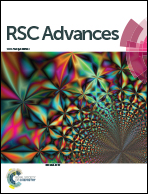Synergistic effects from graphene oxide nanosheets and TiO2 hierarchical structures enable robust and resilient electrodes for high-performance lithium-ion batteries†
Abstract
We present a facile one-step route for successfully fabrication of a flowerlike rutile/anatase TiO2 hierarchical structure decorated with graphene oxide (GO). The primary oriented TiO2 nanorods, with diameter of 10–20 nm, were closely wrapped with GO nanosheets to build secondary hierarchical architecture with a size of 1.07 μm, resulting in a compact, mechanically robust and stable structure, which is completely different from the TiO2 nanoparticle/graphene composite obtained by using graphene as precursor under the same conditions. When used as an anode materials for lithium-ion batteries (LIBs), it exhibited a high reversible capacity and long cycling stability with high discharge capacities of 211 mA h g−1 at 1C over 500 cycles and 130 mA h g−1 at 5C after 1000 cycles. To better understand what underlying factors lead this TiO2@GO hierarchical structure to achieve its excellent electrochemical performance, we have synthesized a series of bare TiO2 hierarchical structures with systematic phase evolution changing from rutile to rutile/anatase and anatase. The effect of crystal phase on the electrochemical performance is then discussed, and the anatase TiO2 electrode exhibited the best electrochemical performance among the bare TiO2 electrodes. However, the rutile/anatase TiO2@GO hierarchical structure demonstrated much better performance than the anatase TiO2 electrode, which is ascribed to the synergistic effects from the TiO2 hierarchical structure and GO nanosheets. This study will further guide the fabrication of functional nanocomposites by applying the “two is better than one” strategy.


 Please wait while we load your content...
Please wait while we load your content...